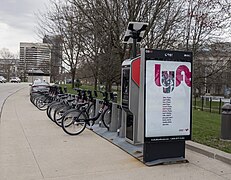Genoa Park
History
The park was expanded from 2011 to 2015, along with the parks along the entire Scioto River. The river was stagnant and muddy due to the Main Street Dam, a low head dam built in 1918 to control flooding, but which doubled the width of the river to 600 feet (180 m). The dam removal in 2013, along with sediment removal, narrowed the river to 300 feet (91 m), giving the city access to 33 acres (13 ha) of previously submerged shoreline. The parks have helped revitalize the city's downtown area.
Attributes
The park follows the curve of the Scioto River on its western bank. The Oval, an open green space, was underwater prior to the Main Street Dam removal in 2013.
The park features an amphitheater and fountains. Public artwork and monuments include Celebration of Life, the Columbus Police Memorial, several works as part of Scioto Lounge, and the statue of Lucas Sullivant.
The river bank features a riparian zone, a natural line of plants along the river, keeping soil from eroding into the water.
Gallery
-
Before the park's construction, 1974
-
Park sign by Broad Street
-
View from Rhodes State Office Tower
-
CoGo bikeshare station
See also
References
- ^ "Genoa Park". columbus.gov. City of Columbus, Ohio. Archived from the original on October 22, 2018. Retrieved October 21, 2018.
- ^ "Genoa Park and Riverfront Amphitheater". The Scioto Mile. City of Columbus Recreation & Parks Department. Archived from the original on 2015-12-26.
- ^ Schneider, Keith (May 31, 2016). "Open Spaces Bring Light to Downtown Columbus". The New York Times. Archived from the original on February 11, 2018. Retrieved April 23, 2020.
- ^ "Central Ohio Parks: The Scioto Greenways transforms Downtown Columbus". Columbus Monthly. June 29, 2016. Archived from the original on May 15, 2021. Retrieved April 23, 2020.



